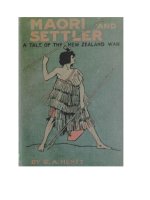4 planning and creating a value proposition the offer
Bạn đang xem bản rút gọn của tài liệu. Xem và tải ngay bản đầy đủ của tài liệu tại đây (611.88 KB, 29 trang )
Planning and Creating A
Value Proposition: The
Offer
Opening Vignette
Smart Spacing
Hangers
What is the Offer?
The offer is the value proposition to
the customer stating what you will
give the customer in return for taking
the action your marketing
communication asks him/her to take.
It includes:
The manner of presentation (media, creative, etc.)
The request for a response
Creating Need-Satisfying
Offers
Is part of on-going customer
relationship management (CRM)
that drives the direct and
interactive marketing process.
When creating the Offer or
Value Proposition …
Always
remember
the
40/40/20
rule!
The “40/40/20 Rule”
states…
The success of any DM effort is
determined by:
The right lists (40%)
The right offer (40%)
The right creative (20%)
3 Characteristics of an
Effective Offer (Lois Geller)
Believability
It has to make sense to the consumer
Involvement
It must attempt to get the customer
involved
Creativity
It sets you apart from all the others
Planning the Offer: 4
Steps
1: Establish Objectives of the Offer
“What is the offer designed to do?”
Continuity sell? Cross-sell? Up-sell?
2: Decide on Attractiveness of the Offer
Make attractive as possible, as “freebies”
3: Reduce Risk of the Offer
Offer free trial or examination period of offer a
money back guarantee
4: Select a Creative Appeal
Offer appeals can be either rational or
emotional
Continuity Selling
Continuity refers to offers that are
continued on a regular (weekly,
monthly, quarterly, annually) basis.
AKA- “club offers”
Examples
Book clubs, CD clubs, and magazine
subscriptions
Cross-Selling
Cross selling is when new, related
or even unrelated products are
offered to the customer.
Beneficial strategy of direct
marketing for profit maximization
from current customer base.
Copyright© 2010 Pearson Education,
Inc. Publishing as Prentice Hall
Up-Selling
Up-selling is the promotion of more
expensive products or services
over the product or service
originally discussed or purchased.
8 Components of the Offer
1.
2.
3.
4.
5.
6.
7.
8.
Product or Service
Pricing/Payment Terms
Trial or Examination Period
Guarantees
Sweepstakes or Contests
Gifts and Premiums
Let’s now
Time Limits
examine
each
Continuity
component
…
Product or Service
It must satisfy the needs or wants
of the target consumer to whom it
will be presented
Product or service features must
be understood
Pricing/Payment Terms
Price skimming - begin price at highest
level
Penetration strategy-begin with low price
Price elasticity measures the consumer's
responsiveness or sensitivity to price
changes
COD, BML, Delayed payment, &
installments
Price expression in the offer
Examples of Ways to Express
Price in an Offer
Basic price statement
“One year supply for only $12.99”
Price stated as a fraction “One-half off when ordered by May 1st”
Price stated by unit
Price savings stated by percentage “Save 30% when ordered by May 1st”
Price savings stated by unit
Price savings stated by dollar amount
Price savings based on introduction “Save $15 on your initial subscription”
Price savings based on multiple purchases
Price based on promotional offer
“Now only $2.49 an issue”
“First two issues are free”
“Save $25”
“Save $2.98 one two”
“Buy one, get one free”
Trial or Examination
Period
Helps overcome the risk factor of
DM
Very effective
Guarantees
Instrumental in overcoming a
potential buyer’s reluctance to
purchase an unseen product from
a remote location
Example:
30 day money back guarantee
Double your money back
Sweepstakes or
Contests
Often perforated tear-offs, diecuts, tokens, and stamps, as well
as answers to questions,
problems, or puzzles, are used.
Check state & local regulations.
Gifts and Premiums
Effective device
for stimulating or
increasing
response
Can be offered for
buying, trying, or
inquiring
Time Limits
A part of the offer
often involves
limited quantity
as well as
specified time
period
“While supplies
last”
Continuity
Positive option-customer must
specifically request shipment for
each offer in a series
Negative option- the shipment is
sent automatically unless the
customer specifically requests
that it not be
more controversial
5 Steps to Creating an
Offer
1.
2.
3.
4.
5.
Perform Market Research
Determine the Terms of the Offer
Target the Offer
Test the Offer
Execute the Offer
Step 1: Perform Market
Research
Analyze Customer
Needs & Wants
Determine
Customer
Motivations
Develop Customer
profile(s)
Step 2: Determine the Terms of
the Offer – (Product
Details)
1.
2.
3.
4.
5.
A choice of sizes
A choice of colors
Personalization
Product Specifications
Product Accessories
Step 3: Targeting An Offer
What am I selling?
Who am I selling to?
Why am I selling this now?
What do I want my Prospect to do?









